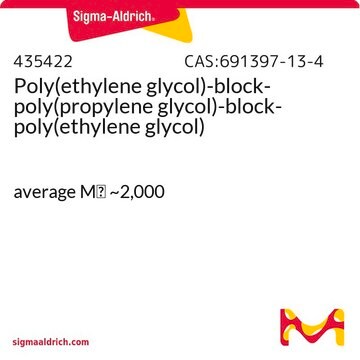If this product has an expiration or retest date, it will be shown on the Certificate of Analysis (COA, CofA). If there is no retest or expiration date listed on the product's COA, we do not have suitable stability data to determine a shelf life. For these products, the only date on the COA will be the release date; a retest, expiration, or use-by-date will not be displayed.
For all products, we recommend handling per defined conditions as printed in our product literature and website product descriptions. We recommend that products should be routinely inspected by customers to ensure they perform as expected.
For products without retest or expiration dates, our standard warranty of 1 year from the date of shipment is applicable.
For more information, please refer to the Product Dating Information document: https://www.sigmaaldrich.com/deepweb/assets/sigmaaldrich/marketing/global/documents/449/386/product-dating-information-mk.pdf
Wichtige Dokumente
202339
Poly(propylenglycol)
average Mn ~2,000
Synonym(e):
PPG, Poly-(propylenoxid)
Größe auswählen
Größe auswählen
About This Item
Empfohlene Produkte
Dampfdichte
>1 (vs air)
Qualitätsniveau
Dampfdruck
<0.01 mmHg ( 20 °C)
Mol-Gew.
average Mn ~2,000
Enthält
130-190 ppm proprietary phenolic antioxidant
Brechungsindex
n20/D 1.451
Viskosität
300 cSt(25 °C)(lit.)
Hydroxylzahl
56 mg KOH/g
Dichte
1.005 g/mL at 25 °C
SMILES String
CC(O)CO
InChI
1S/C6H14O3/c1-5(8)4-9-6(2)3-7/h5-8H,3-4H2,1-2H3
InChIKey
DUFKCOQISQKSAV-UHFFFAOYSA-N
Suchen Sie nach ähnlichen Produkten? Aufrufen Leitfaden zum Produktvergleich
Verwandte Kategorien
Allgemeine Beschreibung
Anwendung
- Korrosionsschutzmittel für Baustahl in saurer Lösung.
- Ausgangsmaterial für die Synthese von Epoxidharz/Polyurethan-Hybridnetzwerken mittels Frontalpolymerisation.
Lagerklassenschlüssel
10 - Combustible liquids
WGK
WGK 1
Flammpunkt (°F)
445.0 °F - closed cup
Flammpunkt (°C)
229.44 °C - closed cup
Persönliche Schutzausrüstung
Eyeshields, Gloves
Hier finden Sie alle aktuellen Versionen:
Besitzen Sie dieses Produkt bereits?
In der Dokumentenbibliothek finden Sie die Dokumentation zu den Produkten, die Sie kürzlich erworben haben.
Kunden haben sich ebenfalls angesehen
-
How can I determine the shelf life / expiration / retest date of this product?
1 Antwort-
Hilfreich?
-
-
How is shipping temperature determined? And how is it related to the product storage temperature?
1 Antwort-
Products may be shipped at a different temperature than the recommended long-term storage temperature. If the product quality is sensitive to short-term exposure to conditions other than the recommended long-term storage, it will be shipped on wet or dry-ice. If the product quality is NOT affected by short-term exposure to conditions other than the recommended long-term storage, it will be shipped at ambient temperature. As shipping routes are configured for minimum transit times, shipping at ambient temperature helps control shipping costs for our customers. For more information, please refer to the Storage and Transport Conditions document: https://www.sigmaaldrich.com/deepweb/assets/sigmaaldrich/marketing/global/documents/316/622/storage-transport-conditions-mk.pdf
Hilfreich?
-
Aktive Filter
Unser Team von Wissenschaftlern verfügt über Erfahrung in allen Forschungsbereichen einschließlich Life Science, Materialwissenschaften, chemischer Synthese, Chromatographie, Analytik und vielen mehr..
Setzen Sie sich mit dem technischen Dienst in Verbindung.








